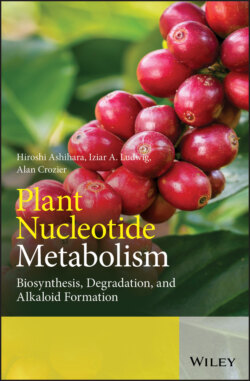Читать книгу Plant Nucleotide Metabolism - Hiroshi Ashihara - Страница 22
1.3.3 Pyridines
ОглавлениеPyridine (46) is a basic heterocyclic organic compound. It is structurally related to benzene, with one methine group replaced by a nitrogen atom, and was discovered in 1849 by a Scottish chemist, Thomas Anderson, as one of the constituents of bone oil. Pyridine-related compounds include the catabolites nicotinate (47) and nicotinamide (48), and quinolinate (49) and NMN (50), which are intermediates of the biosynthesis of NAD (51) and NADP. These compounds act as common coenzymes involved in many redox reactions, carrying electrons from one reaction to another in all living cells. Each coenzyme consists of pyridine purine nucleotides joined through their phosphate groups. NAD(P) exists in two forms: an oxidized and reduced form abbreviated as NAD(P)+ and NAD(P)H respectively.
